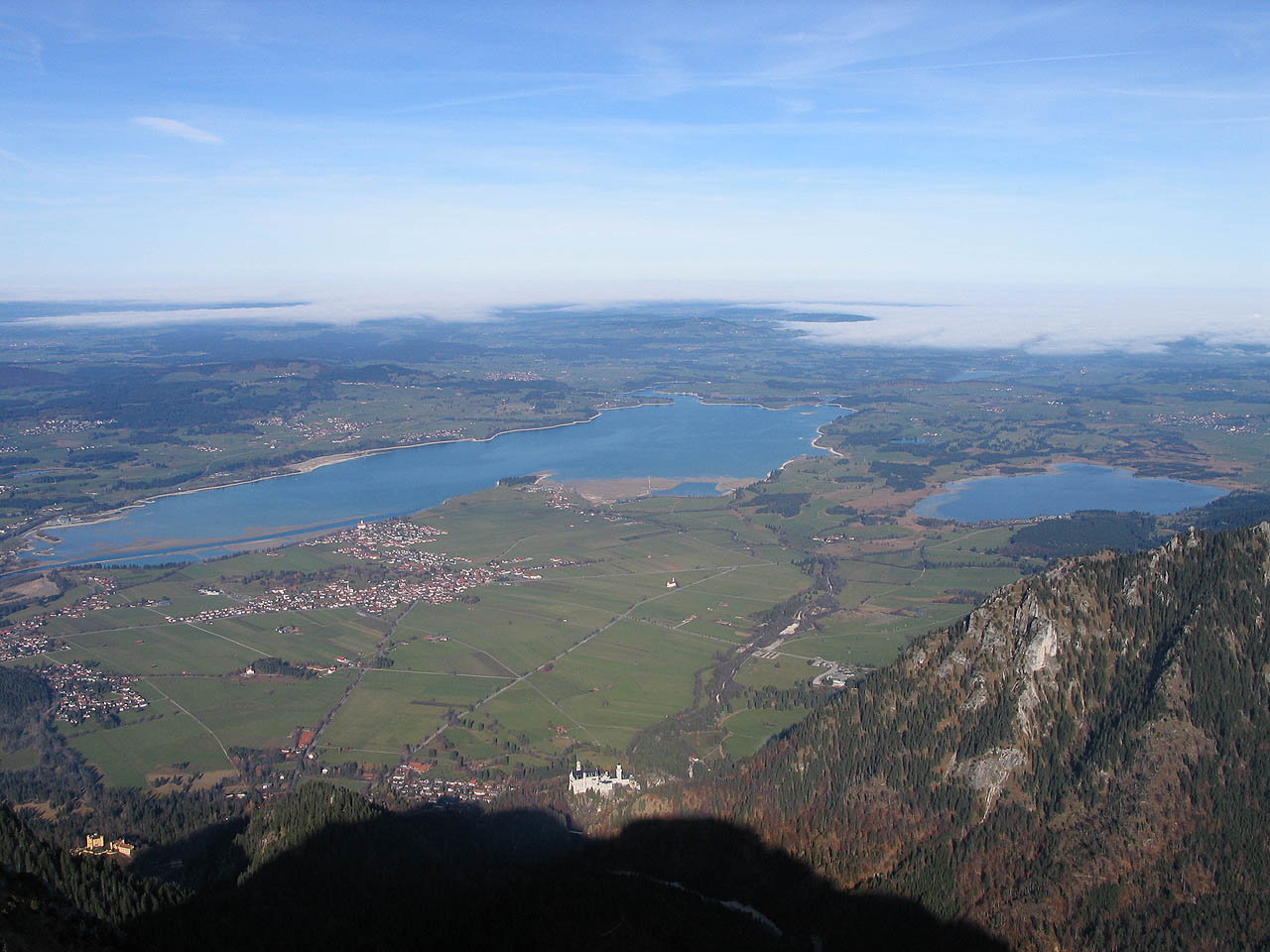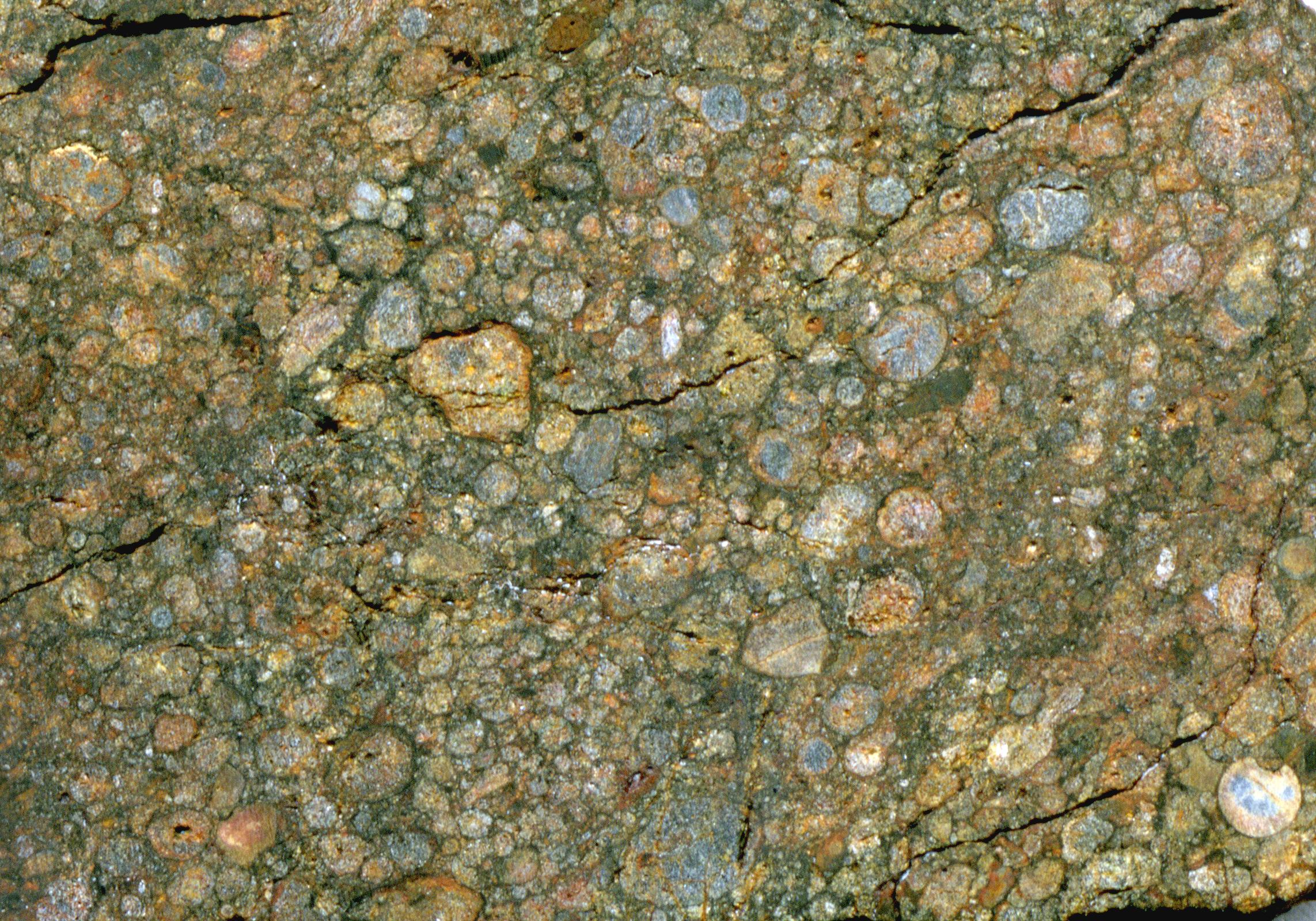|
Neuschwanstein (meteorite)
Neuschwanstein was an enstatite chondrite (type EL6) meteorite that fell to Earth on 6 April 2002 at 22:20:18 GMT near Neuschwanstein Castle, Bavaria, at the Germany–Austria border. The original meteorite burst into several fragments at a height of about 22 kilometers (14 miles) above the ground. The fragments descended on an area of several square kilometers. Three fragments were recovered with a total mass of about . Neuschwanstein was the first meteorite in Germany, and the fourth in the world, that was monitored by one of the world's fireball networks, namely by the European Fireball Network. Photographing the meteor simultaneously from several locations allowed accurate reconstruction of its trajectory. Meteorite fall The trace of the Neuschwanstein meteor within the Earth's atmosphere began at a height of about , about east-northeast of Innsbruck, with an entry angle of about 49° to the horizontal, and ended above the Earth's surface. Shortly before that it split ... [...More Info...] [...Related Items...] OR: [Wikipedia] [Google] [Baidu] |
Chondrite
A chondrite is a stony (non-metallic) meteorite that has not been modified, by either melting or differentiation of the parent body. They are formed when various types of dust and small grains in the early Solar System accreted to form primitive asteroids. Some such bodies that are captured in the planet's gravity well become the most common type of meteorite by (whether quickly, or after many orbits) arriving on a trajectory toward the planet's surface. Estimates for their contribution to the total meteorite population vary between 85.7% and 86.2%. Their study provides important clues for understanding the origin and age of the Solar System, the synthesis of organic compounds, the origin of life and the presence of water on Earth. One of their characteristics is the presence of chondrules (from the Ancient Greek χόνδρος ''chondros'', grain), which are round grains formed as molten, or partially molten droplets, in the space by distinct minerals, that normally consti ... [...More Info...] [...Related Items...] OR: [Wikipedia] [Google] [Baidu] |
Garmisch-Partenkirchen
Garmisch-Partenkirchen (; Bavarian: ''Garmasch-Partakurch''), nicknamed Ga-Pa, is an Alpine ski town in Bavaria, southern Germany. It is the seat of government of the district of Garmisch-Partenkirchen (abbreviated ''GAP''), in the Oberbayern region, which borders Austria. Nearby is Germany's highest mountain, Zugspitze, at above sea level. The town is known as the site of the 1936 Winter Olympic Games, the first to include alpine skiing, and hosts a variety of winter sports competitions. History Garmisch (in the west) and Partenkirchen (in the east) were separate towns for many centuries, and still maintain quite separate identities. Partenkirchen originated as the Roman town of ''Partanum'' on the trade route from Venice to Augsburg and is first mentioned in the year A.D. 15. Its main street, Ludwigsstrasse, follows the original Roman road. Garmisch was first mentioned some 800 years later as ''Germaneskau'' ("German District"), suggesting that at some po ... [...More Info...] [...Related Items...] OR: [Wikipedia] [Google] [Baidu] |
Mainz
Mainz () is the capital and largest city of Rhineland-Palatinate, Germany. Mainz is on the left bank of the Rhine, opposite to the place that the Main (river), Main joins the Rhine. Downstream of the confluence, the Rhine flows to the north-west, with Mainz on the left bank, and Wiesbaden, the capital of the neighbouring state Hesse, on the right bank. Mainz is an independent city with a population of 218,578 (as of 2019) and forms part of the Frankfurt Rhine-Main, Frankfurt Rhine-Main Metropolitan Region. Mainz was founded by the Roman Empire, Romans in the 1st century BC as a military fortress on the northernmost frontier of the empire and provincial capital of Germania Superior. Mainz became an important city in the 8th century AD as part of the Holy Roman Empire, capital of the Electorate of Mainz and seat of the Elector of Mainz, Archbishop-Elector of Mainz, the Primate (bishop), Primate of Germany. Mainz is famous as the birthplace of Johannes Gutenberg, the inventor of ... [...More Info...] [...Related Items...] OR: [Wikipedia] [Google] [Baidu] |
Max Planck Society
The Max Planck Society for the Advancement of Science (german: Max-Planck-Gesellschaft zur Förderung der Wissenschaften e. V.; abbreviated MPG) is a formally independent non-governmental and non-profit association of German research institutes. Founded in 1911 as the Kaiser Wilhelm Society, it was renamed to the Max Planck Society in 1948 in honor of its former president, theoretical physicist Max Planck. The society is funded by the federal and state governments of Germany. Mission According to its primary goal, the Max Planck Society supports fundamental research in the natural, life and social sciences, the arts and humanities in its 86 (as of December 2018) Max Planck Institutes. The society has a total staff of approximately 17,000 permanent employees, including 5,470 scientists, plus around 4,600 non-tenured scientists and guests. The society's budget for 2018 was about €1.8 billion. As of December 31, 2018, the Max Planck Society employed a total of 23,767 staff, of whom ... [...More Info...] [...Related Items...] OR: [Wikipedia] [Google] [Baidu] |
Tyrol (state)
Tyrol (; german: Tirol ; it, Tirolo) is a States of Austria, state (''Land'') in western Austria. It comprises the Austrian part of the historical County of Tyrol, Princely County of Tyrol. It is a constituent part of the present-day Euroregion Tyrol–South Tyrol–Trentino (together with South Tyrol and Trentino in Italy). The capital of Tyrol is Innsbruck. Geography The state of Tyrol is separated into two parts, divided by a strip. The larger territory is called North Tyrol (''Nordtirol'') and the smaller area is called East Tyrol (''Osttirol''). The neighbouring Austrian state of Salzburg (state), Salzburg stands to the east, while on the south Tyrol has a border with the Italy, Italian province of South Tyrol (Trentino-Alto Adige/Südtirol) which was part of the Austro-Hungarian Empire before the First World War. With a land area of , Tyrol is the third-largest state in Austria. Tyrol shares its borders with the federal state of Salzburg in the east and Vorarlberg in th ... [...More Info...] [...Related Items...] OR: [Wikipedia] [Google] [Baidu] |
Neuschwanstein 2
Neuschwanstein Castle (german: Schloss Neuschwanstein, , Southern Bavarian: ''Schloss Neischwanstoa'') is a 19th-century historicist palace on a rugged hill above the village of Hohenschwangau near Füssen in southwest Bavaria, Germany. The palace was commissioned by King Ludwig II of Bavaria as a retreat and in honour of Richard Wagner. Ludwig chose to pay for the palace out of his personal fortune and by means of extensive borrowing, rather than Bavarian public funds. Construction began in 1869, but was never fully completed. The castle was intended as a private residence for the King, until he died in 1886. It was open to the public shortly after his death. Since then more than 61 million people have visited Neuschwanstein Castle. More than 1.3 million people visit annually, with as many as 6,000 per day in the summer. Location The municipality of Schwangau lies at an elevation of at the southwest border of the German state of Bavaria. Its surroundings are chara ... [...More Info...] [...Related Items...] OR: [Wikipedia] [Google] [Baidu] |
Ochsenälpeleskopf
Ochsenälpeleskopf is a mountain of Bavaria, Germany Germany,, officially the Federal Republic of Germany, is a country in Central Europe. It is the second most populous country in Europe after Russia, and the most populous member state of the European Union. Germany is situated betwe .... Mountains of Bavaria Ammergau Alps Mountains of the Alps {{Bavaria-geo-stub ... [...More Info...] [...Related Items...] OR: [Wikipedia] [Google] [Baidu] |
Hoher Straußberg
Hoher Straußberg is a mountain of Bavaria, Germany Germany,, officially the Federal Republic of Germany, is a country in Central Europe. It is the second most populous country in Europe after Russia, and the most populous member state of the European Union. Germany is situated betwe .... Mountains of Bavaria Ammergau Alps Mountains of the Alps {{Bavaria-geo-stub ... [...More Info...] [...Related Items...] OR: [Wikipedia] [Google] [Baidu] |
German Aerospace Center
The German Aerospace Center (german: Deutsches Zentrum für Luft- und Raumfahrt e.V., abbreviated DLR, literally ''German Center for Air- and Space-flight'') is the national center for aerospace, energy and transportation research of Germany, founded in 1969. It is headquartered in Cologne with 35 locations throughout Germany. The DLR is engaged in a wide range of research and development projects in national and international partnerships. DLR also acts as the German space agency and is responsible for planning and implementing the German space programme on behalf of the German federal government. As a project management agency, DLR coordinates and answers the technical and organisational implementation of projects funded by a number of German federal ministries. As of 2020, the German Aerospace Center had a national budget of €1.261 billion. Overview DLR has approximately 10.000 employees at 30 locations in Germany. Institutes and facilities are spread over 13 sites, ... [...More Info...] [...Related Items...] OR: [Wikipedia] [Google] [Baidu] |
Heterogeneous
Homogeneity and heterogeneity are concepts often used in the sciences and statistics relating to the uniformity of a substance or organism. A material or image that is homogeneous is uniform in composition or character (i.e. color, shape, size, weight, height, distribution, texture, language, income, disease, temperature, radioactivity, architectural design, etc.); one that is heterogeneous is distinctly nonuniform in at least one of these qualities. Heterogeneous Mixtures, in chemistry, is where certain elements are unwillingly combined and, when given the option, will separate. Etymology and spelling The words ''homogeneous'' and ''heterogeneous'' come from Medieval Latin ''homogeneus'' and ''heterogeneus'', from Ancient Greek ὁμογενής (''homogenēs'') and ἑτερογενής (''heterogenēs''), from ὁμός (''homos'', “same”) and ἕτερος (''heteros'', “other, another, different”) respectively, followed by γένος (''genos'', “kind”); - ... [...More Info...] [...Related Items...] OR: [Wikipedia] [Google] [Baidu] |
Ordinary Chondrite
The ordinary chondrites (sometimes called the O chondrites) are a class of stony chondritic meteorites. They are by far the most numerous group, comprising 87% of all finds. Hence, they have been dubbed "ordinary". The ordinary chondrites are thought to have originated from three parent asteroids, with the fragments making up the H chondrite, L chondrite and LL chondrite groups respectively. Origin It is suspected that they are not representative of typical asteroid parent bodies, but rather of a select few which are advantageously placed to send impact fragments to Earth-crossing orbits. Such positions are e.g. near Kirkwood gaps and/or secular resonances in the main asteroid belt. In fact, only the one rather insignificant asteroid 3628 Božněmcová has been identified to have a spectrum close to the ordinary chondrites. A probable parent body of the H chondrites (comprising about 46% of the ordinary chondrites) is 6 Hebe, but its spectrum is dissimilar due to what is likel ... [...More Info...] [...Related Items...] OR: [Wikipedia] [Google] [Baidu] |
Czechoslovakia
, rue, Чеськословеньско, , yi, טשעכאסלאוואקיי, , common_name = Czechoslovakia , life_span = 1918–19391945–1992 , p1 = Austria-Hungary , image_p1 = , s1 = Czech Republic , flag_s1 = Flag of the Czech Republic.svg , s2 = Slovakia , flag_s2 = Flag of Slovakia.svg , image_flag = Flag of Czechoslovakia.svg , flag = Flag of Czechoslovakia , flag_type = Flag(1920–1992) , flag_border = Flag of Czechoslovakia , image_coat = Middle coat of arms of Czechoslovakia.svg , symbol_type = Middle coat of arms(1918–1938 and 1945–1961) , image_map = Czechoslovakia location map.svg , image_map_caption = Czechoslovakia during the interwar period and the Cold War , national_motto = , anthems = ... [...More Info...] [...Related Items...] OR: [Wikipedia] [Google] [Baidu] |



.jpg)



